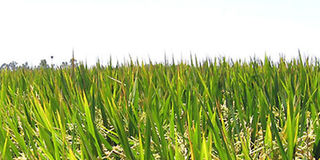Ahero rice farmers staring at losses as birds invade paddies

Ahero irrigation scheme in Nyanza. Ahero Multipurpose Co-operative Society chairman Clarkson Abiero said farmers had incurred about Sh10 million in losses, an estimate of 950 bags, following the destruction by birds. Photo/FILE
What you need to know:
- The flocks, mainly of weaver birds, descend on the lands at 6am, leaving in their wake destruction and pain.
The Quelea birds are known to fly in huge flocks in search of early maturing cereals, annual wild grasses and grains.
Now about 600 rice farmers affected by the birds are appealing for the national government to contain the menace.
James Otieno and his colleagues are each armed with sticks and huge balls of mud. But they have a huge task on their hands, to chase away hungry birds that have invaded their rice paddies.
The flocks, mainly of weaver birds, descend on the land early in the morning at about 6am, leaving in their wake destruction at Kisumu’s Ahero Irrigation Scheme.
Otieno makes small balls of mud targeting the flock of birds at the rice fields.
For these rice farmers, this is the only weapon they can use to scare away the quelea (weaver) birds.
“We have been here as early as 5am trying to chase away these birds from our rice field. It is a tedious job but what choice do we have?” asks Otieno.
As soon as the flock of birds leave his zone, they quickly land in another to feed on the rice grains. It appears like a choreographed feeding frenzy. Except that the birds are only attracted by the food, guided by their own biological maps.
Ahero Multipurpose Co-operative Society Chairman Clarkson Abiero says every day, at least 90 farmers and their family members, wake up early to battle the destructive birds at the rice fields. It is often a lost battle: Mud balls doesn’t hit the birds often enough and they always dodge and eat some more.
“Three blocks, namely A, B and G with mature rice ready for harvest are the most affected. We need at least four people per acre to scare away the birds,” says Mr Abiero, referring to the paddies here.
Apart from the huge losses caused by the birds, now farmers have to dig deeper into their pockets to hire youth to scare away the birds.
“Throughout the day, we have to pay them Sh400 each to scare away the birds. This comes as an additional cost for rice farmers,” says Abiero.
LOSSES
Currently, the rice farmers have incurred a loss of sh10million, an estimate of 950 bags following the destruction, according to estimates by the rice farming society.
Ahero Irrigation Scheme has at least 2,000 acres of rice paddy field which are partitioned in blocks for easier management.
“We are really trying to get rid of the birds but our efforts have yielded nothing. We have had attacks of birds before but this is the worst ever,” says Otieno.
“We fear that the rest of the six blocks which are at the flowering stage are at risk,” he said.
The quelea birds are known to fly in huge flocks in search of early maturing cereals, annual wild grasses and grains.
Now about 600 rice farmers affected by the birds are appealing for the national government to contain the menace.
Abiero said the region depended on the national government initiative which sprayed the paddy field after every three years to contain the birds.
National Irrigation Western Kenya Board senior scheme’s manager Joel Tanui said already officers have been dispatched to identify the bird species destroying the rice farms and get rid of them.
“Two weeks ago, birds were controlled in Budalangi by spraying. Seems they have migrated from other parts of the country. Areas like the Mwea rice scheme and other neighbouring schemes have managed to control birds,” said Mr Tanui.
Mr Tanui says the department of pest control under Ministry of Agriculture controls the birds by spraying their roosting sites.
“The plane normally comes at around 7pm when the birds are roosting. During the evening hours, the chemical is sprayed to eliminate the birds normally when roosting along River Nyando,” said Tanui.
The spraying should be done every season of harvesting to control the bird menace.




